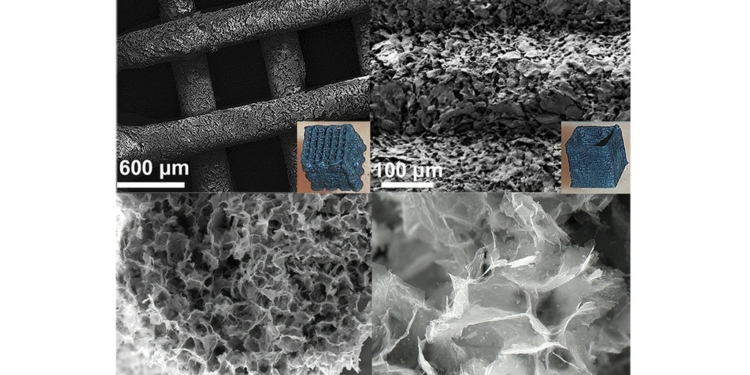Source: University of Manchester article
For the first time, a team of researchers, from the Department of Materials and the National Graphene Institute at The University of Manchester have formulated inks using the 2D material MXene, to produce 3D printed interdigitated electrodes.
As published in Advanced Materials, these inks have been used to 3D print electrodes that can be used in energy storages devices such as supercapacitors.
MXene, a ‘clay-like’ two-dimensional material composed of early transition metals (such as titanium) and carbon atoms, was first developed by Drexel University. However, unlike most clays, MXene shows high electrical conductivity upon drying and is hydrophilic, allowing them to be easily dispersed in aqueous suspensions and inks.
Graphene was the world’s first two-dimensional material, more conductive than copper, many more times stronger than steel, flexible, transparent and one million times thinner than the diameter of a human hair.
Since its isolation, graphene has opened the doors for the exploration of other two-dimensional materials, each with a range of different properties. However, in order to make use of these unique properties, 2D materials need to be efficiently integrated into devices and structures. The manufacturing approach and materials formulations are essential to realise this.
Dr Suelen Barg who led the team said: “We demonstrate that large MXene flakes spanning a few atoms thick, and water can be independently used to formulate inks with very specific viscoelastic behaviour for printing. These inks can be directly 3D printed into freestanding architectures over 20 layers tall. Due to the excellent electrical conductivity of MXene, we can employ our inks to directly 3D print current collector-free supercapacitors. The unique rheological properties combined with the sustainability of the approach open many opportunities to explore, especially in energy storage and applications requiring the functional properties of 2D MXene in customized 3D architectures.”
Wenji and Jae, PhD students at the Nano3D Lab at the University, said: “Additive manufacturing offers one possible method of building customised, multi-materials energy devices, demonstrating the capability to capture MXene’s potential for usage in energy applications. We hope this research will open avenues to fully unlock the potential of MXene for use in this field.”
“The unique rheological properties combined with the sustainability of the approach open many opportunities to explore, especially in energy storage and applications requiring the functional properties of 2D MXene in customized 3D architectures.” said Dr Suelen Barg, School of Materials
The performance and application of these devices increasingly rely on the development and scalable manufacturing of innovative materials in order to enhance their performance.
Supercapacitors are devices that are able to produce massive amounts of power while using much less energy than conventional devices. There has been much work carried out on the use of 2D materials in these types of devices due to their excellent conductivity as well as having the potential to reduce the weight of the device.
Potential uses for these devices are for the automotive industry, such as in electric cars as well as for mobile phones and other electronics.
featured image credit: University of Manchester


































